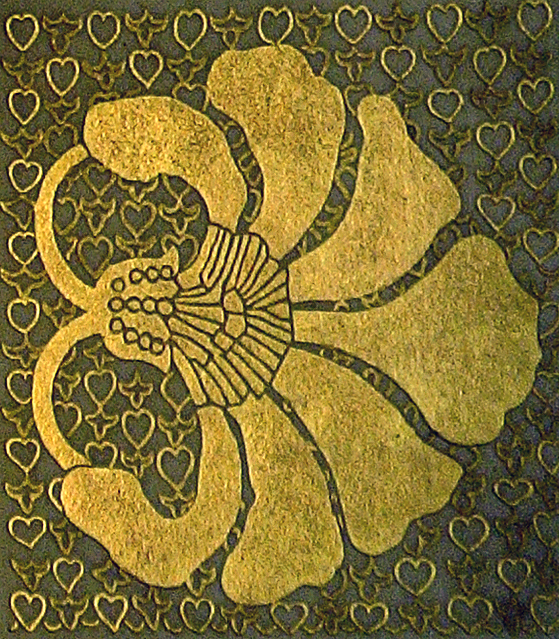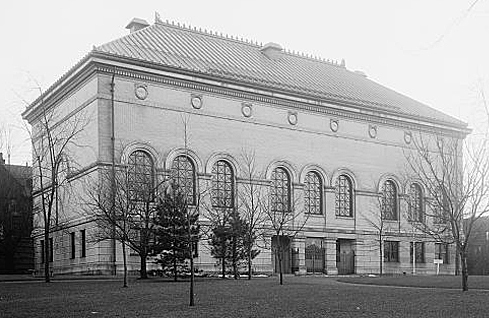 Helen Bigelow Merriman and the Worcester Art Museum
Helen Bigelow Merriman and the Worcester Art Museum
Helen Bigelow Merriman and her husband, Rev. Daniel Merriman, settled in Worcester at the beginning of the city’s golden age, when a number of community leaders were turning their attention to the arts. Helen Merriman took an active role in the Worcester Art Society, which was established in 1877, one year before their arrival in  Worcester. She presented art lectures to the society and contributed to its exhibitions works from her personal collection of European and American masters. Helen Merriman was also involved in the Worcester Art Students Club, an organization established in 1880 to encourage practicing artists. Its exhibitions included some of Merriman’s own work.
Worcester. She presented art lectures to the society and contributed to its exhibitions works from her personal collection of European and American masters. Helen Merriman was also involved in the Worcester Art Students Club, an organization established in 1880 to encourage practicing artists. Its exhibitions included some of Merriman’s own work.
The establishment of an art museum had been a goal of both Worcester art organizations, but the most significant move toward this end occurred in 1891 when Stephen Salisbury III, as a member of the St. Wulstan Society, a literary society consisting of all men, offered funding to start a museum. Because it was thought that the museum should be separate from the St. Wulstan Society, it was to be several years before the museum was founded.
The Merrimans were the perfect couple to help Salisbury realize his goal. Together they had spearheaded the building of a magnificent facility for the Congregational Church. Both also had a love of learning and respect for culture, which was fostered by frequent and extensive world travel. They were constantly in consultation with heads of other institutions, artists, experts and critics, both in the US and abroad, regarding museum construction and administration.
 It was no surprise that Rev. and Mrs. Merriman were among the fifty people that Salisbury gathered at his home in February 1896 to establish the Worcester Art Museum. Both were named original corporators and trustees, and, upon Mr. Salisbury’s insistence, Daniel Merriman was named the Museum’s first president. The only couple to serve on the original Board of Directors, the Merrimans were among the five top donors to the Museum’s building fund. Working closely with architect Stephen Earle, they helped shape the museum’s classical-revival style original building of 1897.
It was no surprise that Rev. and Mrs. Merriman were among the fifty people that Salisbury gathered at his home in February 1896 to establish the Worcester Art Museum. Both were named original corporators and trustees, and, upon Mr. Salisbury’s insistence, Daniel Merriman was named the Museum’s first president. The only couple to serve on the original Board of Directors, the Merrimans were among the five top donors to the Museum’s building fund. Working closely with architect Stephen Earle, they helped shape the museum’s classical-revival style original building of 1897.
Rev. and Mrs. Merriman also played a vital role in the early administration of the Worcester Art Museum. Daniel Merriman, who prepared the Museum’s constitution and by-laws, served on the Executive Committee and the Committee on Buildings and Grounds, while Helen Merriman served on the Committee on Instruction and the Committee on the Museum. Helen was particularly helpful in carrying out the Museum’s educational mission. As a practicing artist, she played an important role in attracting the Boston Impressionist Philip Hale to oversee the Museum’s program of studio instruction.
Helen Merriman also took a lead in building the Museum’s art collection art. She not only gave money to assist with art purchases, but was also among the first to acquire artwork for the purpose of giving it to the Museum. In 1901 she purchased from an Amsterdam dealer Pierre Subleyras’ portrait of Maria Felilce Tibaldi
and donated it to the Museum the same year. On another trip to Amsterdam, Helen Merriman bought a portrait of Cornelia Bruynseels, the daughter of a Utrecht mint master, painted by Paulus Moreelse around 1600. Donated to the Museum one month after she acquired it, Helen Merriman’s gift marked the beginning of the Museum’s important holdings of Dutch art.
 Undoubtedly Helen Merriman influenced many gifts to the Museum, such as the painting entitled Hayrick by Sarah Wyman Whitman,which was donated by Merriman’s friend, Isabella Stewart Gardner
Undoubtedly Helen Merriman influenced many gifts to the Museum, such as the painting entitled Hayrick by Sarah Wyman Whitman,which was donated by Merriman’s friend, Isabella Stewart Gardner
Helen Merriman also sought out important works for the Museum to purchase. In 1908, for example, she examined at a Boston gallery John Singleton Copley’s portrait of John Bours, which then Museum acquired.
 Over the years Helen Merriman was generous in lending to the Museum’s exhibitions, including works by seventeenth-century Dutch masters and American painters like Edmund Tarbell and Arthur B. Davies. Long a champion of women artists, she lent to the Museum’s first exhibition a portrait by her friend Sarah Wyman Whitman and to its 1909 annual exhibition a portrait by one of America’s most recognized women artists, Cecilia Beaux. Listed as "portrait of a lady", Beaux’s painting is in fact a portrait of Helen Merriman which was ultimately acquired by the Museum in 2007.
Over the years Helen Merriman was generous in lending to the Museum’s exhibitions, including works by seventeenth-century Dutch masters and American painters like Edmund Tarbell and Arthur B. Davies. Long a champion of women artists, she lent to the Museum’s first exhibition a portrait by her friend Sarah Wyman Whitman and to its 1909 annual exhibition a portrait by one of America’s most recognized women artists, Cecilia Beaux. Listed as "portrait of a lady", Beaux’s painting is in fact a portrait of Helen Merriman which was ultimately acquired by the Museum in 2007.
About a year after the Beaux commission, the Merrimans turned to the Boston painter and former Worcester Art Museum instructor Joseph DeCamp
to paint a likeness of Rev. Merriman. This portrait, which was exhibited in the Worcester Art Museum’s 1910 annual exhibition, was donated to the Museum by Helen Merriman in 1913 following her husband’s death.

Intent on upholding the high standards both she and her husband had set for the Worcester Art Museum, Helen Merriman remained active with the institution even though by 1901 she was residing between Boston and Stonehurst, to these essays, her elaborate summer home in northern New Hampshire. Helen Merriman was never shy about expressing her opinion regarding the Museum’s acquisitions, including a number of works by John Singer Sargent. In 1922 at age 78, Helen Merriman stepped down from the Committee on the Museum and the following year from the Board. By the time she died in 1932, the Worcester Art Museum was recognized as one of the finest in the country, thanks in no small part to the vision, intelligence and generosity of the Merrimans.